How Your Business Can Fight ATM Skimming

Skimming, where criminals use hidden digital readers to steal debit and credit card information, is a pervasive threat that can result in significant financial losses for businesses. The FBI estimates that ATM and point-of-sale (POS) skimming generates more than $1 billion for criminals annually. So if your business offers or operates these machines, you need to assess your risk and take steps to prevent skimming from happening on your premises.
How it happens
Skimming is widespread among thieves because it’s a relatively straightforward crime to perpetrate. Fraudsters secretly place a skimming device — usually a plastic overlay — on an ATM or POS reader to capture card data and users’ PINs. Alternatively, they might use hidden cameras focused on the keypad or even a “dummy” keypad. They then take the stolen information, create counterfeit cards called clones and use them to withdraw funds from victims’ accounts.
Most victims don’t know their accounts have been compromised until they see their statements. Consumers generally are protected from large personal losses by liability laws, but businesses can suffer significantly. If, for example, an ATM or POS reader in your retail space is targeted, you could face customer lawsuits and lost business.
Protecting against losses
To protect your business, situate ATMs and POS readers in well-lit locations near security cameras. Make sure your cameras clearly capture the equipment and surrounding space. Also regularly review surveillance footage to ensure no one has interfered with the cameras or your machines. Other ways to help prevent and detect skimming include:
Installing security devices. If tamper-evident seals and keypad covers (to shield cardholders’ PIN input) aren’t already on your equipment, ask your vendor to provide them.
Warning customers. Place posters detailing the dangers of skimming near ATMs. Stickers on or near ATMs and POS readers should instruct users to shield the keypad when entering their PINs.
Performing routine inspections. Hold employees accountable for inspecting ATMs and POS readers according to a schedule. You can make inspections easier to perform by measuring the equipment — including the length, breadth and depth. Any discrepancies should alert employees to the addition of an overlay or other skimming device.
Acting quickly. If you, an employee or customer spot signs of tampering or skimming, shut down the ATM or POS reader immediately and report your suspicions to the police and your vendor. Removing power can prevent the future communication of stolen card information already in the skimming device, so consider unplugging the machine until someone can inspect it.
Ongoing vigilance
Protecting against ATM and POS reader skimming requires ongoing vigilance and a multi-layered approach. Consider subscribing to newsletters offered by your bank and law enforcement agencies that can keep you updated on the tools and techniques criminals use to skim.
(This is Blog Post #1657)


